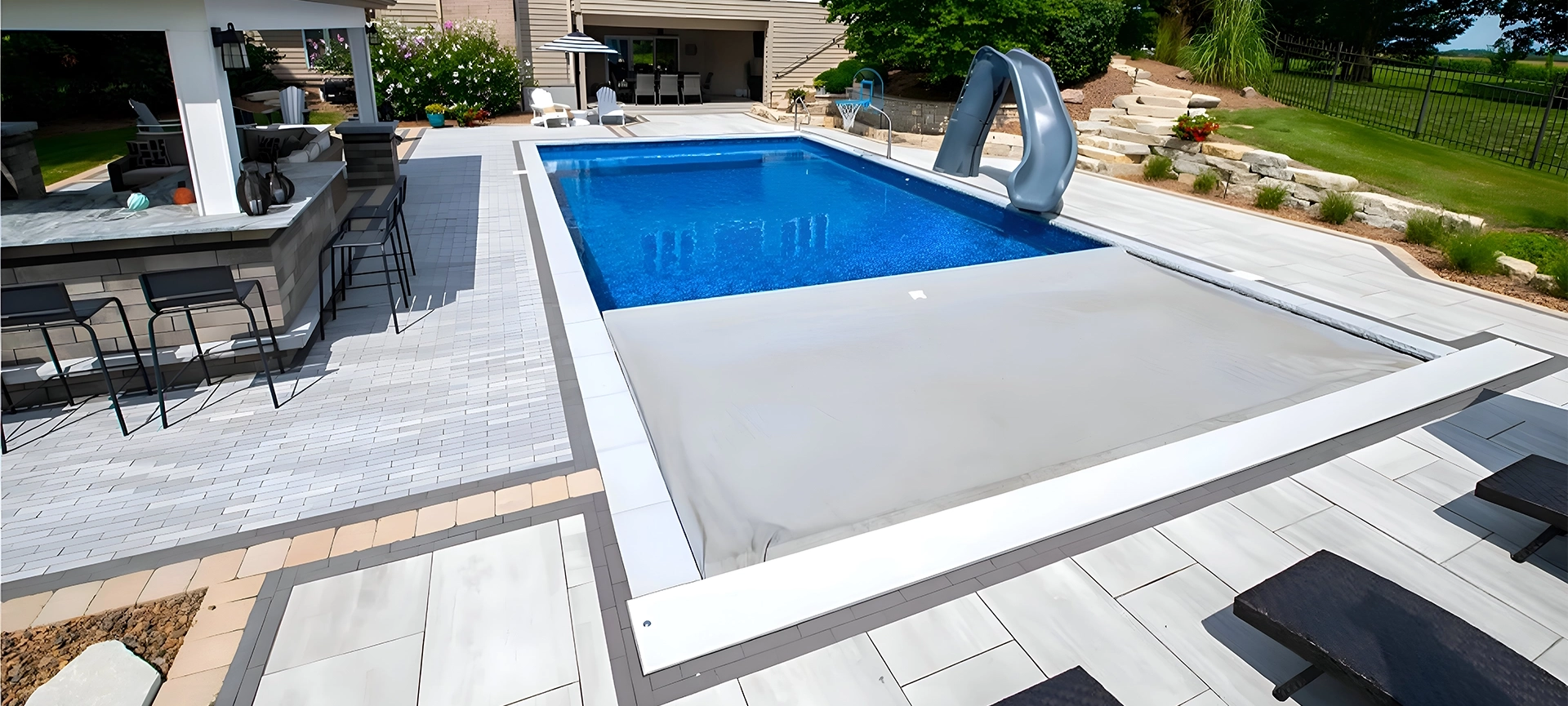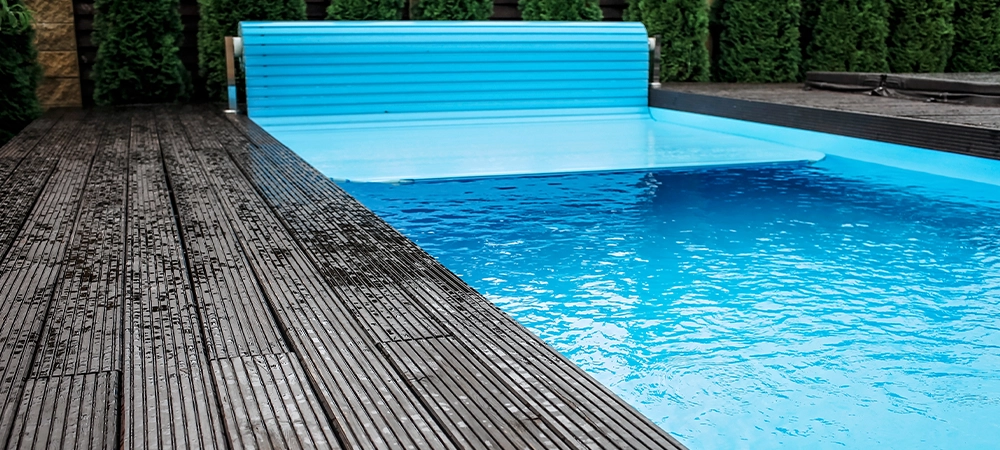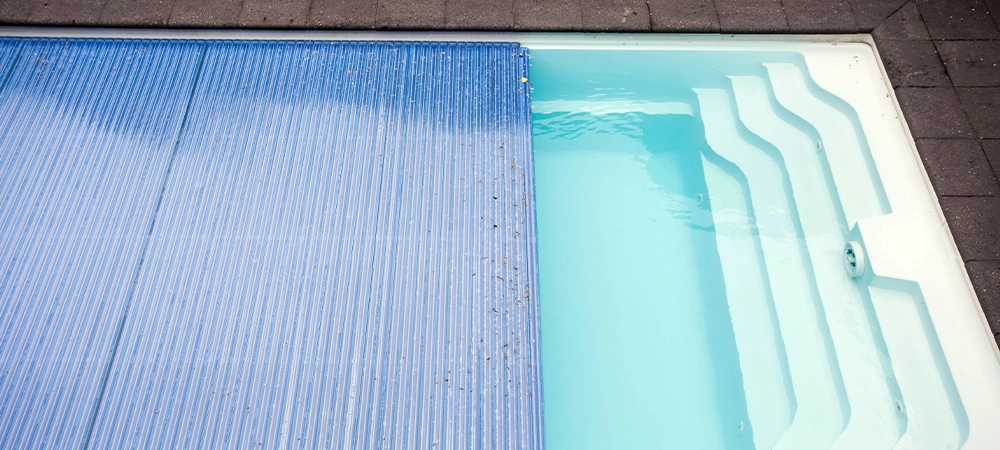When is the Best Time to Install a Pool Cover?

For homeowners, a swimming pool is more than just a luxury—it’s a place for family gatherings, relaxation, and fun. But keeping that pool in top shape requires more than regular cleaning and chemical balancing. One of the most effective ways to safeguard your pool is by using a cover, and the timing of its installation is critical.
The best time to install a pool cover depends on seasonal changes, pool usage, and the type of cover you choose. Installing too late means more cleaning, higher costs, and unnecessary wear on pool equipment. Installing too early could limit your use of the pool during warm months.
By knowing the ideal timing, you protect your investment, save money, and extend the life of your pool.
Related Article: How Much Do Automatic Pool Covers Cost
Why Pool Covers Are Worth the Investment?
Before looking at timing, it’s important to understand why a pool cover matters. Without one, your pool is exposed to leaves, insects, dust, and changing weather conditions. This debris not only makes the water dirty but forces filters and pumps to work harder, increasing energy use and reducing equipment life.
A pool cover also helps retain heat, meaning you can use your pool longer into the season without expensive heating costs. It reduces water loss from evaporation and keeps chemicals balanced for longer, lowering maintenance bills.
For families with children or pets, safety covers add peace of mind by preventing accidental entry. In short, a pool cover saves time, money, and stress while adding a vital layer of protection.
Effective pool planning includes choosing the right cover early, which reduces maintenance costs and extends the pool’s lifespan.
Seasonal Timing: When Should You Install a Pool Cover?
The best time to install a pool cover changes with the seasons. Each season brings unique challenges that can affect pool health and costs.
Spring
Spring marks the start of pool preparation. While many homeowners rush to open their pools, it’s also the time when pollen, dirt, and sudden rainstorms can disrupt water quality. Installing a light mesh or solar cover during this season helps minimize early debris buildup. It also controls algae growth by reducing direct sunlight exposure, meaning your pool is easier to balance chemically when it’s time to swim.
Summer
During the summer, pools are in constant use, so many people avoid covering them. However, a solar cover is highly effective in hot months. It traps heat during cooler nights, prevents evaporation on hot days, and reduces chemical loss caused by strong UV rays.
For pool owners who use heaters, installing a summer cover lowers energy bills significantly. While you may not use it every day, even part-time summer use can lead to noticeable savings.
Related Article: How to Open a Pool for the Summer
Autumn
Autumn is widely considered the best time to install a pool cover. As temperatures drop and trees shed their leaves, pools quickly become filled with organic debris. Leaves and acorns can clog filters, stain liners, and promote algae growth if left unchecked.
Installing a cover before the heavy leaf fall begins saves hours of cleaning and prevents long-term damage. Autumn installation ensures your pool is ready for winter, reducing the risk of freeze damage to plumbing and equipment.
Winter
In regions like the Greater Toronto Area (GTA) and York Region, winter brings freezing temperatures and snow. A winter pool cover is essential during this season. Solid or mesh covers block debris, protect against ice damage, and keep your pool secure until spring.
Installing the cover before the first frost is critical. Waiting too long increases the risk of cracks in the liner, damaged pumps, and costly repairs once the thaw begins.

Choosing the Right Type of Pool Cover
Selecting the right cover depends on your goals and the time of year. Each option has specific strengths.
Installing the wrong type of cover at the wrong time can limit effectiveness, so understanding their uses helps you make a smarter choice:
- Solar Covers: Best for spring and summer. They trap heat, conserve energy, and extend the swimming season.
- Mesh Covers: Ideal for autumn. They let water pass through but block leaves, twigs, and larger debris.
- Solid Covers: Designed for long-term winter use, they block all sunlight and debris, keeping water clearer.
- Safety Covers: Reinforced with strong materials, these are suitable year-round for families who prioritize accident prevention.
Signs It’s Time to Cover Your Pool
While the calendar is a good guide, practical signs can also indicate when to install your cover:
- Frequent debris, such as falling leaves, enters the pool.
- Rising chemical costs due to sunlight and evaporation.
- A drop in daily pool usage as temperatures fall.
- Weather forecasts predict frost, snow, or heavy rainfall.
- Water levels are lowering more quickly than normal due to evaporation.
These signals suggest that installing your cover sooner rather than later will save money and prevent future problems.
Related Article: The Ultimate Pool Restoration Process for a Stunning Backyard Upgrade
DIY vs Professional Installation
Pool owners often ask whether they should install a cover themselves or hire professionals. While do-it-yourself methods can work for smaller or above-ground pools, professional installation is highly recommended for larger in-ground pools.
A professional team ensures the cover is correctly sized and tensioned, that anchors are secure, and that the material suits your specific pool environment. A poorly fitted cover can sag, collect stagnant water, and even collapse under snow weight. Professional installation also reduces the risk of damage to the liner and ensures your investment lasts as long as possible.
A strong cover protects your investment by preventing damage during and after pool restoration, keeping the water and structure secure.
Related Article: Signs It’s Time to Restore or Renovate Your Pool
Cost Benefits of Installing at the Right Time
Timing your pool cover installation is as much about saving money as it is about convenience. Installing at the right time ensures:
- Lower water bills: By reducing evaporation, you’ll refill less often.
- Reduced chemical costs: Balanced water remains stable for longer periods.
- Cleaner water: Prevents debris buildup that would otherwise require hours of cleaning or costly service calls.
- Protected equipment: Covers reduce freeze damage in winter, extending pump and filter life.
- Energy efficiency: Heat-retaining covers lower heating costs in spring and summer.

Maintenance After Installation
Simply installing a cover is not enough. To keep it effective, homeowners should:
- Clear leaves and branches from the surface weekly.
- Pump away excess water buildup on solid covers.
- Tighten straps and check for anchor wear.
- Inspect the material for tears or weakened seams each season.
- Schedule a professional inspection before winter begins.
Regular maintenance ensures your cover performs well and lasts its full lifespan.
Moving Forward with Pool Protection
Timing is everything when it comes to pool maintenance. While covers are beneficial in every season, autumn stands out as the best time for installation. Acting before leaves fall and frost sets in keeps your pool cleaner, reduces costs, and prevents long-term damage.
For homeowners across the GTA and York Region, Green Side Up Contracting provides expert advice and professional installation services. With the right cover, your pool will be secure, efficient, and ready for use when warm weather returns.
Call Green Side Up Contracting today to book your pool cover installation and protect your pool investment all year round.
Frequently Asked Questions
1. What happens if I don’t use a pool cover?
Pools without covers accumulate debris, lose heat, and experience higher evaporation rates. This leads to more frequent cleanings, chemical use, and repair costs.
2. Can a pool cover help me extend the swimming season?
Yes. Solar covers retain warmth, making it possible to swim comfortably several weeks longer in spring and autumn without relying heavily on heaters.
3. How do I know if my cover is installed correctly?
A well-installed cover should be taut across the surface, anchored securely, and free of gaps. Sagging areas or loose edges mean it needs adjustment.
4. Are there pool covers for unusual shapes or large pools?
Custom covers are available to fit irregularly shaped or oversized pools. Professional installers can measure and supply covers tailored to any design.
5. How often should I replace a pool cover?
On average, covers last 7–10 years. However, replace sooner if you notice tears, weakened seams, or anchors that no longer hold properly.
6. Do covers affect water chemistry during winter?
Yes. Covers help maintain pH and chlorine balance by preventing contamination from debris and limiting sunlight exposure that encourages algae growth.
7. Can pool covers withstand heavy snow?
Safety and winter covers are designed to handle snow loads if properly tensioned. However, regular checks and snow removal prolong their life.
8. What’s the difference between mesh and solid covers in winter?
Mesh covers allow water through but block debris, while solid covers block both sunlight and water. Solid covers keep water clearer but require pumps for drainage.
9. How do I clean a pool cover at the end of the season?
Use a soft broom or hose to remove debris. Avoid harsh chemicals, as they can damage the material. Let the cover dry before storage to prevent mildew.
10. Is professional installation worth the cost?
Yes. Correct fitting ensures long-term durability, prevents sagging, and reduces the chance of winter damage, making professional installation a worthwhile investment.
